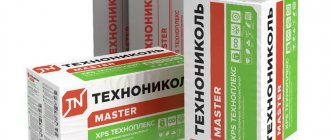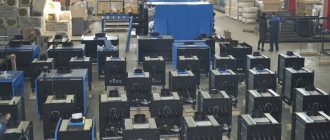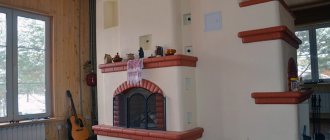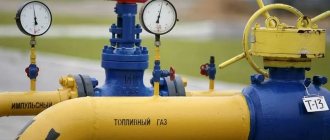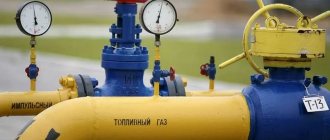You are the owner of a country house where main gas is not supplied, and the electrical networks are not designed for heavy loads, hence the allocated limit of 5 kW for all needs. Another variation on the theme: you are a rural resident of Ukraine, where the cost of blue fuel has jumped to 7.2 UAH. (0.3 USD) per 1 m³, so you cannot use it due to low income. There are other, more complex situations.
In this situation, you are faced with the task of providing heating for a private house without gas and electricity, preferably economically. Let's identify alternative heating methods and look at all the nuances associated with their implementation.
Stove heating
Stove heating at home.
This is one of the most ancient types of heating, which remains popular in our time. There are a large number of types of stoves that can be used to heat a private home. The most widespread are stoves with medium heat capacity, which are heated twice a day. Such stoves can be not only heating, but also combined (for cooking food).
Capital and operating costs are low. To build such a furnace, there will be enough brick, clay, sand and lime. Metal is needed only to build the door, valves and grate. In order to do this, you will need coal or firewood, which you can always prepare yourself. This stove creates a special atmosphere of comfort in the house. The Russian stove is a kind of analogue of a foreign fireplace, which has roots deep in antiquity, but fits perfectly into the design of a modern Russian home.
The difficulty of stove heating lies in its not very convenient operation, because the stove must be constantly monitored, coal or firewood must be added. We must not forget about the two-time firebox and the replenishment of fuel supplies and its storage. The stove needs to be constantly looked after, cleaning not only the chimney, but also the room itself, since soot often gets inside the room. In addition to all this, the fire hazard is high and there is a possibility of carbon monoxide poisoning.
If your house is small, keep in mind that the furnace area takes up approximately 5% of the total usable area of the house. On the other hand, if the house is large, the efficiency of the furnace will be low. After all, the heating will be uneven, and the need for firewood or coal will be considerable. Therefore, if there is no gas in a country house, stove heating is only suitable if the house itself is small. Most of all, such heating is suitable for a small country house.
Autonomous gasification is an alternative, but not effective
There are a number of systems that can be called autonomous gasification. For this purpose, special gas tanks and gas storage tanks are purchased, and it is necessary to ensure that the containers are regularly filled with fuel. In addition, it will be necessary to comply with certain rules for the maintenance of such complex equipment - for example, a gas accumulation/storage tank must be deepened into the ground.
You can, of course, experiment and heat a house without gas using household propane cylinders, but this is a labor-intensive process and very expensive, which is why the autonomous gasification method has not become popular among the population.
There are also alternative heating systems that until recently seemed like science fiction - we are talking about solar energy and geothermal systems.
How to heat a house without gas
Other heating options without gas:
- Electric Energy. The simplest organizational alternative to gas heating in a private home is electricity. Currently, there is practically not a single corner of our country where electrification has not yet been carried out. On the other hand, maintaining electric boilers and heaters will be quite expensive.
- Diesel fuel. It is used both in mobile heating devices and in boilers. Although the cost of diesel fuel is small, quite a lot of it will be required to maintain the constant operation of the boiler equipment. In addition, you should take into account the specific strong smell that accompanies the operation of diesel heaters.
- Coal. An excellent option for heating a private home without gas for regions where this fuel is directly available. A simple arithmetic calculation of the financial costs of heating a house using coal shows that this will require 4 times less money than in the case of diesel fuel.
- Peat. Another way to obtain heat without gas. It goes on sale in the form of pressed briquettes.
- Firewood. Perfect for areas where firewood is freely available. In other situations, this option, how to heat a house without gas, is quite problematic due to the rapid consumption of heating material. In this case, it is much more convenient to use pellets (pellets from wood processing waste). Pellet boilers, as a rule, are equipped with special automation that independently loads fuel.
Coal and firewood act as the main type of fuel for stoves and fireplace equipment: it is the most optimal option for heating a house when there is not only gas, but also electricity. You can build a stove or fireplace yourself, from refractory bricks, or purchase it ready-made. Store models are made of steel or cast iron and have significant decorative qualities. In addition to directly heating the home, appliances of this type allow you to cook food on them: especially for this purpose, their design includes an oven and a hob.
Diesel fuel
Diesel oil is another type of fuel used to heat a home. Its specific heat of combustion is about 10,180 kcal/kg or 8,650 kcal/l (taking into account the average density of the liquid, which differs between winter and summer diesel engines).
The efficiency of a diesel fuel boiler is about 90%. The retail price of one liter of diesel fuel is about 28.5 rubles, respectively, 1 Gcal will cost 3,650 rubles, which means that organizing heating using diesel fuel is a rather expensive undertaking. In addition, the cost of diesel fuel is unstable; its price has risen sharply more than once recently.
Heating with brine-water heat pumps
To implement the project, it is necessary to drill a well up to 200 m in depth. The pipes should be placed in it in a U-shape along with the solution. You can arrange a heat exchanger that will be located at a depth of at least 5 m. This is necessary to reduce the difference in the heat received in different months of the year.
Heating circuit based on a brine-water pump.
The depth and number of wells are determined based on the ability to obtain the required 50 W of thermal energy. It is obtained from each linear meter of a drilled well. As a result, alternative heating of a private house using heat pumps according to the water-water or brine-water scheme is characterized by minimal heating costs compared to indicators characterizing other types of heating systems.
Electricity generation
As you know, a home can also be heated with electricity, ideally from an alternative source. At the moment it can be obtained using:
- wind power plant;
- mini-hydroelectric power station;
- solar panels.
The electricity obtained in this way really does not cost anything and this is a huge plus. If there are constantly blowing winds in the region or a river flowing nearby, extracted energy can become a panacea. The electric heating system will be completely autonomous.
The situation is a little worse with solar batteries, since their efficiency is low. To generate more or less significant power, you will need many semiconductor panels.
Hence the huge disadvantage is the high cost of the above equipment. For this reason, such electricity generation is not available to most ordinary citizens. And natural conditions are not conducive everywhere: there are no winds or rivers, and solar energy generated in the summer cannot be stored for the winter.
If not gas, then what?
The most accessible, cheap and efficient heating of a country house without gas is heating with wood. In rural areas, this method is most relevant due to the availability of material. Firewood also requires storage and storage, which is not difficult in the village. Devices for burning wood are conventional stoves and solid fuel boilers. The stove has the advantage that you can cook food on it, and you can even sleep on a Russian stove!
The principle of operation of a boiler using wood or other solid fuel is to heat the coolant, which circulates through the heating system and heats the house. Radiators, batteries or registers are used to generate concentrated heat. Solid fuel boilers are also developing in several directions - there are gas generator models, pyrolysis units and classic devices that operate according to a simplified scheme.
Electric boilers, which are offered by domestic and foreign manufacturers, are reliable in operation, durable in operation, maintainable and have high efficiency. The disadvantage of these devices is that the cost of electricity in light of its consumption by the boiler will be high, and the larger the house, the higher the costs will be.
An alternative to the usual and traditional furnaces and boilers is the use of innovative, environmentally friendly technologies. This is the fuel that nature itself has prepared for us, and it hardly needs to be processed. For example, a heat pump that operates on the temperature difference between soil layers at different depths and the ambient temperature on the surface.
The heat pump is increasingly used in country houses, as it does not require storing fuel for the winter, is environmentally friendly, technologically advanced, durable and relatively cheap. The disadvantage of a heat pump is the cost of the device and its installation, but it is comparable to the savings when operating a heating system, since it does not incur any additional costs - for repair, maintenance and preventive maintenance of equipment.
Solar batteries, wind generators and geothermal sources are the prerogative of mountainous areas, but people also live in the mountains, so the percentage of use of such unusual heat sources is very high. For example, in Russia, electricity produced from such natural sources is used by about 15% of the population.
On pellets
Pellets are an environmentally friendly fuel used in solid fuel boilers. Essentially, these are granules obtained from wood waste. Pellets have a number of advantages over firewood - they can be used in boilers with automatic fuel supply, in addition, the moisture content of pellets is only 8-10%.
The specific heat of combustion of pellets is within 4.2 kcal/kg. Taking into account the cost of about 5 thousand rubles per ton, the price of 1 Gcal will be 1.5 thousand rubles.
Heating a country house with electricity
Electric boiler
Modern electric boiler for heating a country house. Such a boiler has many operating parameters, a very important one of which is its power. The required power is determined individually, first of all, it depends on the heated area, wall material, and the quality of the house’s thermal insulation
The next type of heating a country house without gas: heating with electricity is the simplest, safest and cleanest way to organize heating. When using an electric heater, its efficiency approaches 100%. An electric water boiler is simple in design, relatively inexpensive, and there is no need for a chimney, ventilation, or a separate room.
Warm electric floors
IMPORTANT! If warm electric floors serve as the main source of heat in the room, then the power of such floors is 150-180 W per square meter. With this type of heating, the heated floor area must be at least 70% of the total area of the room
Warm electric floors, subject to interfloor insulation standards, are even more profitable than the electric-water option:
— there are no intermediate heat losses; — building structures are heated directly; — there is no bulky boiler equipment; — minimal space occupied by communications; — optimal heat distribution; - the system practically does not require maintenance; - the cost is often lower than that of water systems.
An electric heating cable or film is both a heat generator and a heating device.
Electric convectors are even cheaper, but they dry the air and pick up fine dust, overheating it. Convectors are a practical and affordable option for a summer cottage with periodic heating, but in a permanent residential building they should not be used as the main system. However, in new generation devices with ceramic heaters, the inherent disadvantages of convectors have almost been eliminated.
Heating with electricity has many advantages and only one drawback, but a decisive one: the high cost of electricity.
Air conditioners
Air conditioning is the most affordable and simplest alternative source of home heating. You can install one powerful one on the entire floor or one in each room.
The best option for using an air conditioner is in late spring or early autumn, when it is not too cold outside and you don’t have to start the gas boiler yet. This will reduce gas consumption due to electricity and not exceed the monthly gas consumption rate.
Important points:
- The boiler and air conditioner must be linked to each other to work as a pair. That is, the boiler must see that the air conditioner is working and not start working while the room is warm. A wall thermostat is indispensable here.
- Heating with electricity is not cheaper than gas. Therefore, you should not completely switch to heating with air conditioners.
- Not all air conditioners can be used in freezing temperatures.
Thermal energy from alternative sources
Can natural sources of thermal energy provide an alternative to gas heating in a private home? Despite the development of this area of energy, humanity will not abandon the burning of fossil and biological fuels any time soon. Alternative heating today is used only as an auxiliary option.
Using a Heat Pump
The principle of operation of a heat pump is that the equipment helps to extract thermal energy from a natural source and move it indoors to heat it
When deciding how to heat a house using a heat pump, pay attention to the features of the available options:
- “Air-to-air” - the equipment functions as a split system in heating mode.
- “Air-water” - the operating principle is the same as in the first option, but the thermal energy of the outside air enters the water circuit and heating equipment.
- “Water-to-water” - thermal energy is extracted from a reservoir or groundwater and used to heat the coolant;
- “Earth-water” - to extract thermal energy from the soil and heat the coolant, a geothermal circuit of pipes is installed.
To make a house warm using these technologies, you will need to use electricity. To obtain 3-4 kW of heat, 1 kW of electricity is consumed. In conditions of limited power consumption, the heat pump is able to cope with the heat supply to a house with an area of up to 150 m2, provided that the climate is not characterized by prolonged frosts.
Installing a heat pump for an autonomous heating system will cost a significant amount, and it is difficult to expect that these costs will pay off in the coming years of operation.
Using a solar collector
Groups of glass tubes through which the coolant circulates are designed to be heated by sunlight, or more precisely, by infrared radiation. Heating a cottage without gas using only solar collectors is impossible
:
- effective heating is possible only in clear sunny weather during the warm season - in winter and on gloomy days the sun is not enough for the heating system to function properly;
- before and after sunset the collector does not receive thermal energy;
- The design is volatile - in order for the coolant to circulate well, an electric motor is needed.
Among the best solutions for the use of alternative energy is the installation of a heat accumulator to accumulate thermal energy transferred by the collector. This will help save energy, which is used by the main heat source (usually a solid fuel boiler).
Solid fuel boiler
A solid fuel boiler with automatic fuel supply is one of the best options for heating a house without gas.
True, our pellets are inferior in quality to European ones; they have a higher ash content and moisture content. The last parameter can reach 15% - this is due to unsatisfactory storage conditions. In this regard, the calorie content of this fuel may differ from that stated by the manufacturer.
In addition, pellets are not yet so widespread, which means that in the absence of competitors, the manufacturer or supplier can dictate their terms and inflate the price.
When purchasing a universal boiler with replaceable burners that allow you to operate on gas and diesel fuel, you will have to pay about 50 thousand rubles, which means that the difference with a pellet boiler will pay off in 4-5 years. In the event of a temporary lack of gas (the project involves the installation of a gas pipeline in the coming years), it is much more profitable to purchase a universal boiler than to use pellets.
Simple heating of a country house: without gas or electricity
Heating your home with electricity is expensive and unreliable. Using gas is cheaper, but it is not always possible to connect it. Then you have to look for other options.
There are several modern alternative sources: energy from the sun, underground resources or an ice-free reservoir. But their installation is quite expensive and complicated. Therefore, a traditional option such as stove heating is often chosen for a dacha.
Pechnoe
It has been known for quite a long time, but remains relevant to this day. There are many variations of stoves. They can heat the entire house or a single room. Sometimes they are connected to a water heating system. Ovens not only heat, but also cook food.
Fuel burns in the combustion chamber. It heats the walls of the stove, which release heat into the house. The following materials are used:
- brick;
- cast iron;
- stainless steel.
The brick takes a long time to heat up, but it also takes longer to release heat. To maintain a comfortable temperature at the dacha, 1-2 heatings per day are required. Steel furnaces heat up quickly and cool down just as quickly. Cast iron ones also heat up quickly, and in terms of heat transfer they occupy an intermediate place between other varieties.
The following is used as fuel:
- firewood;
- coal;
- pallets;
- fuel briquettes.
Advantages and disadvantages
The advantages of heating a dacha with a stove include:
- Autonomy. There is no dependence on gas and electricity.
- Suitable for houses where people do not live permanently.
- You can also cook in the oven.
There are the following disadvantages:
- Requires space to store fuel.
- Brick stoves are quite massive, and it is advisable to lay them together with the house.
- Less heating efficiency.
- If the water circuit is not connected, the rooms far from the stove will be cooler.
- It is necessary to make a chimney.
Waste into income: biogas plants
All alternative energy sources are of natural origin, but double benefits can only be obtained from biogas plants. They process waste from domestic animals and poultry. The result is a certain volume of gas, which, after purification and drying, can be used for its intended purpose. The remaining processed waste can be sold or used on fields to increase yields - a very effective and safe fertilizer is obtained.
Energy can also be obtained from manure, but not in pure form, but in the form of gas
Briefly about technology
Gas formation occurs during fermentation, and bacteria living in manure are involved in this. The waste of any livestock and poultry is suitable for producing biogas, but cattle manure is optimal. It is even added to the rest of the waste for “ferment” - it contains exactly the bacteria needed for processing.
To create optimal conditions, an anaerobic environment is necessary - fermentation must take place without oxygen. Therefore, effective bioreactors are closed containers. To make the process more active, regular mixing of the mass is necessary. In industrial installations, mixers with electric drives are installed for this purpose; in home-made biogas plants, these are usually mechanical devices - from the simplest stick to mechanical mixers that “work” by hand force.
Schematic diagram of biogas plants
Two types of bacteria are involved in the formation of gas from manure: mesophilic and thermophilic. Mesophilic are active at temperatures from +30°C to +40°C, thermophilic - at +42°C to +53°C. Thermophilic bacteria work more efficiently. Under ideal conditions, gas production from 1 liter of usable area can reach 4-4.5 liters of gas. But maintaining a temperature of 50°C in the installation is very difficult and expensive, although the costs are justified.
A little about designs
The simplest biogas plant is a barrel with a lid and a stirrer. The lid has a terminal for connecting a hose through which gas enters the tank. You won’t get a lot of gas from such a volume, but it’s enough for one or two gas burners.
More serious volumes can be obtained from an underground or above-ground bunker. If we are talking about an underground bunker, then it is made of reinforced concrete. The walls are separated from the ground by a layer of thermal insulation; the container itself can be divided into several compartments in which processing will take place with a time shift. Since mesophilic cultures usually work under such conditions, the entire process takes from 12 to 30 days (thermophilic cultures are processed in 3 days), therefore a time shift is desirable.
Scheme of a bunker biogas plant
Manure enters through the loading hopper; an unloading hatch is made on the opposite side, from where processed raw materials are taken. The bunker is not completely filled with the bio-mixture - about 15-20% of the space remains free - gas accumulates here. To drain it, a tube is built into the lid, the second end of which is lowered into a water seal - a container partially filled with water. In this way, the gas is dried - already purified gas is collected in the upper part, it is removed using another tube and can already be choked to the consumer.
Everyone can use alternative energy sources. It is more difficult for apartment owners to implement this, but in a private house they can at least implement all the ideas. There are even real examples of this. People fully provide for their own needs and for their large households.
Features of water heating arrangement
Selecting a system type
So, we figured out what kind of heating to make at the dacha. Now let's take a closer look at water heating, which can be implemented in several ways.
Single-pipe heating circuit with circulation pump
First of all, water heating differs in the way the coolant circulates in the system.
It can be implemented in two ways:
- Natural - the movement of liquid is carried out due to the different densities of hot and cold water, while the system uses an accelerating tank, and the pipes are installed with a constant slope. The advantage of this option is the autonomy of the system, however, for this, the boiler must also be non-volatile.
- Forced - the coolant is driven by a circulation pump. In this case, there are fewer requirements for the system in terms of installation, but the heating of the garden house becomes energy-dependent.
Two-pipe heating system
In addition, an important difference is the radiator connection diagram, which can be:
- Single-pipe - all radiators are connected in series to one pipe, which goes around the perimeter of the room. This method is suitable for small houses, since with a long system length, the batteries are heated unevenly.
- Two-pipe - in this case, the hot coolant and return flow through different pipes, which ensures uniform heating of the batteries. True, in this case the price of the system is higher, since more pipes are required.
Before installing heating in a dacha, it is necessary to prepare a project that should indicate not only the location and number of radiators, but also the power of the heating equipment. On our portal you can get detailed information on how to calculate the power of your heating system.
Photo shows radiator installation
Heating installation
Heating installation should begin with installing the boiler and connecting it to the chimney. Further work is carried out in accordance with the system design - first of all, heating radiators are installed and the pipeline is assembled.
In the places indicated in the diagram, the remaining elements of the system are mounted - a circulation pump, an expansion tank, etc. After completing the work, you must start the system and make sure it is working and there are no leaks. This process is called crimping.
Here, perhaps, are all the main features of arranging heating in a dacha.
Personal experience
I use four heat sources to heat my house: a gas boiler (main), a fireplace with a water circuit, six flat-plate solar collectors and an inverter air conditioner.
Why is this necessary?
- Have a second (backup) heat source if the gas boiler fails or its power becomes insufficient (severe frosts).
- Save on heating. Using different heat sources, you can control the monthly and annual gas consumption rates so as not to switch to a more expensive tariff.
Some statistics
The average gas consumption in January 2016 was 12 cubic meters per day. With a heated area of 200m2 and an additional basement.
| October | November | January | |
| Expense per month | 63,51 | 140 | 376 |
| Minimum | 0,5 | 0,448 | 7,1 |
| Maximum | 5,53 | 10,99 | 21,99 |
| Average per day | 2,76 | 4,67 | 12,13 |
Fluctuations in consumption by day during the month are associated with different street temperatures and the presence of the sun: on sunny days the collectors operate and gas consumption decreases.
We recommend reading:
How to design and make a foundation for sliding gates?
Didn't find an article on a topic that interests you?
Just write a few words in the form at the top of the screen, our search will automatically select suitable articles.
All about country life and construction
Where is Moscow expanding? And what does this mean for summer residents? 586522 Will the Central Ring Road be able to relieve congestion on highways near Moscow? 328461 How to calculate acres of land? 272478 Which areas of the Moscow region are the cleanest and dirtiest in terms of ecology? 234517 Which metro stations will be built in the Moscow region? 210016
How much does it cost to connect a house and land to communications? 157596 Where is it better to live in the Moscow region? Rating of districts 127119 How many acres of land do you need to build a house? 124603 Districts of New Moscow. What are their advantages and disadvantages? 122332 What are the restrictions on construction near rivers and reservoirs? 106600 Which home heating is more profitable: gas or electric? 91610 Building codes and rules for the development of land plots 87137 What exhibitions of finished houses are there in Moscow and the Moscow region? 82492 The best cottage villages in the Moscow region 74987 What houses are currently on sale in the Moscow region? 71058 What are land plots without a contract? 63403 Are the basement and basement considered floors? 59357 Land development from scratch. Where to begin? 56364 Is it possible to leave SNT? 55216 What taxes must be paid for a house, garage, bathhouse and other buildings? 53086 How to re-register a plot? And how much does it cost? 54453 Is it profitable to build a house for sale? 49722 Where will the gas soon be? Gasification plan for villages in the Moscow region 46956 The best places for fishing in the Moscow region 45577 Pitfalls when buying a house
What should you pay attention to? 44219 How to bargain for a house? 43096 Life in a cottage community. Pros and cons 43039 Rating of Moscow region districts by quality of life 46061 Is it worth buying a house in SNT for permanent residence? 45718 Do I need to obtain permission to build a house on my site? 44080 Will a house built in SNT be considered residential? 42271 What to do after purchasing a plot? 38802 How long does it take to build private houses? 36443 The largest and most expensive cottages in Russia 35652 How much will it cost to build your own house? 34879
What is the best material to build a house for permanent residence from? 31842 How to register a rented plot under a house? 31209 Is it worth renting forest land for construction? 29013 How many floors can a cottage be built on? 28775 Ecovillages and ecovillages. What it is? 27789 What is the size of utility bills in cottage villages? 26705 How to build a house on a plot with a slope? 26152 Repair and decoration of a cottage. Work order and all stages 25583 Purchase of a plot with an unregistered house. What are the risks? 24136 Which private houses are warmer in winter? 23893 Division of a house with a plot. How to apply correctly? 23048 Gas to a private house. How to do it? 23048 How to rent out your plot? 22473 Turnkey house construction? Like this? And how much will it cost? 21681 Depreciation of the condition of the house. How to understand? How to calculate? 21108 Modular houses. What it is? 20520 How much will it cost to maintain your home? 20195 Lands of private household plots. What are their pros and cons? 19822 Forest areas (near the forest). What are their pros and cons? 19260 How to change the purpose of a site? 19127 Which is better: Cottage or Townhouse? 18830 Is it possible to turn a dacha into a residential building? 18564
Solar collectors
An excellent alternative to gas heating is solar collectors. Such installations operate smoothly and economically. Collectors are ways to maintain heat in a room for a long time. But the main thing is that under good conditions they can generate electricity. Such installations have both their advantages and disadvantages.
Thus, solar collectors are absolutely safe. Installing such installations is quite simple and quick. Collectors are installed somewhere on the façade of a building. The installation will fit perfectly into the design of the house, since among a wide range you can choose the most suitable option for yourself. But most importantly, collectors provide significant savings in utility costs. Therefore, this type of installation is perfect even for low-income families.
The only drawback of such collectors is that they operate exclusively on solar energy. This determines the specifics of the installation of collectors. In regions where it is sunny almost all year round (usually the south of the country), installing collectors is completely justified. But in northern latitudes these installations will be completely useless.
Work organization
To install a heat pump, you need to make a circuit. If your house is on rocky soil, then one or more wells are drilled into it. Their total length is calculated based on the fact that for every meter of depression in the ground there is about 50 W of energy. If you plan to install a 10 kW heat pump, then you will need wells with a total depth of about 200 m.
If there is a plot of about 600 m² near your house. then you can make an earthen contour. In order to make heating without gas and firewood, it is necessary to install special pipelines at the depth of soil freezing. To obtain 10 kW, the circuit needs to be about 500 m long.
The most preferable option is to use the nearest body of water. It must be flowable and large enough in size. It is necessary to install a water circuit with a total length of 333 m. This length is sufficient to produce 10 kW.
Air circuits are used less often. This is due to the fact that the minimum temperature at which such a pump can operate is -20 °C.
The principle of its operation is the same as that of any refrigeration machine. It consumes electricity and converts it into thermal energy. The pump removes heat from the refrigerated products, and the condenser transfers it to the room. That is, heat is taken from the bowels of the earth.
conclusions
They are disappointing. A cheaper alternative to gas heating that will work in any climate is a myth. At current gas prices, it remains the most profitable source of heat. But his prospects, alas, are gloomy: gas prices will quickly rise, and the price ratio may yet change towards electricity.
Let us repeat - this is far from the only point of view. The video at the end of the article covers this topic differently; You will probably be interested in hearing another position. Warm winters!
Today, natural gas is the most popular and affordable type of fuel for domestic needs and heating. However, fossil reserves are not unlimited, the cost of gas is rising, and connecting to the main line is often impossible or insanely expensive. This forces us to look for other, less conventional ways to heat our homes.


